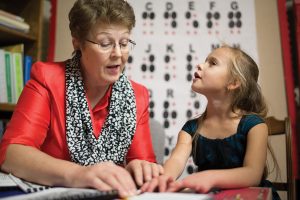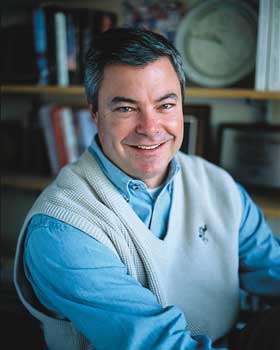Jan Zollinger has transferred her passion for learning to generations of blind children.
On the first day of a sociology class her freshman year at BYU, Jan Pfost Zollinger (BS ’76) volunteered to help a blind classmate read the course textbook. When at the semester’s end the student suggested she consider teaching the blind, Zollinger says she knew immediately that was what she wanted to do.
And almost four decades of working with visually impaired infants, children, adolescents, and young adults have reinforced that decision.
“Blind children are bright, creative, optimistic, and pragmatic,” says Zollinger, named the Braille Institute’s 2014 Teacher of the Year. “I have loved teaching them because they stretch themselves every day and have taught me to do the same.”
That stretching began when she started tackling braille. For her first BYU braille class she “worked really, really hard,” she says—but got a C. Took it again, “worked really, really hard,” and got a B. Understanding the tactile world of braille, with its complex rules, required new ways of thinking and learning, and she started using mnemonics and other tricks to get through.
She believes the challenge has allowed her to better empathize with and encourage her students. “I think the Lord made it hard for me to learn [so] I knew what it was like to struggle.”
That struggle inspired an innovative teaching style. Zollinger, who currently works at the Idaho School for the Deaf and Blind (ISDB) in Twin Falls, incorporates music, drama, dance, poetry, storytelling, and other artistic media into her braille lessons. The goal? To help her students retain what they learn by making connections between abstract braille concepts and meaningful memories.

For nearly 40 years, Jan Zollinger has employed a variety of methods—including music, drama, and poetry—to teach her Idaho students braille.
Photo by Bradley Slade.
“She’s very inventive,” says Brian Darcy, ISDB administrator, noting Zollinger’s emphasis on music to help her students with braille. And though not everyone is always immediately on board with her tactics—“teenagers don’t want to look uncool, even blind teenagers,” Darcy says—Zollinger ultimately “draws them in and won’t let them say no.”
The result of her efforts, Darcy adds, is that her students develop a love for learning. “To inspire a child to want to learn is every educator’s goal, . . . and she does a good job of that,” he says.
Mike Gibson, whose progressive vision loss left him completely blind as a first grader, started working with Zollinger when he was 6. To get and stay up to grade level on his reading, he had to keep working through summer breaks. Jealous of his siblings and friends out playing, he remembers “absolutely hating having to work.” But Zollinger, he says, was always upbeat and encouraging. “By the time we were done, my attitude had improved a lot.”
Gibson, assistive-technology coordinator for Boise State University’s disability resource center, continued working with Zollinger into his high-school years, and he now considers her a friend. “I think that positive nature and her general positive attitude [are] just who she is,” he says.
“If you’re excited about [what you’re teaching], it rubs off,” Zollinger says. And with excitement and motivation, children can learn to read, which, she says, “is the greatest gift I can give my students—it opens up the whole world to them.”
In addition to her ISDB work, Zollinger travels the country helping braille teachers improve their curricula. Ultimately, though, her passion remains working with her students.
“I have been so blessed to have a career I have loved,” Zollinger says. “I would have walked away if my whole heart had not been in teaching, but it always has been.”









